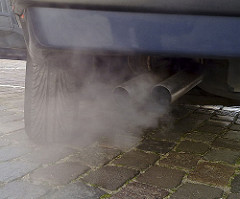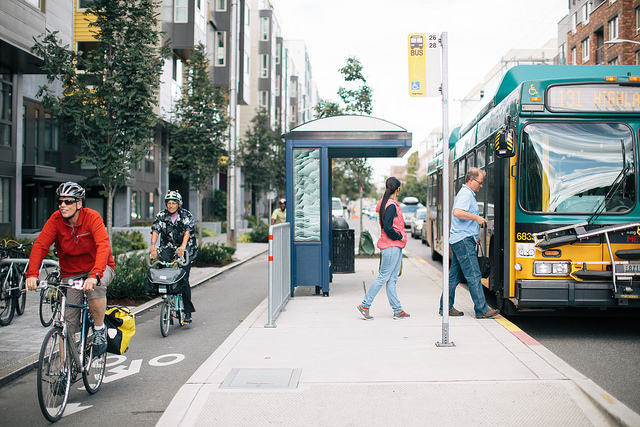People in Washington spend billions of dollars each year on dirty fuels. A big chunk of that money goes to out-of-state oil companies instead of staying in Washington to help create local jobs or improve quality of life. Initiative 1631, a citizen-backed measure to pass a Washington carbon fee, could change that by shifting the transportation sector away from fossil fuels and toward walking, biking, transit, cleaner fuels, and electric vehicles.
Washington residents spend billions on out-of-state oil
Washington residents spend nearly $7 billion per year on dirty fuels to power cars, trucks, and buses. More than half of that cash goes to non-Washington producers of crude oil. For the sake of easy math, let’s say gas in Washington is about $3 per gallon (the state average is actually at $3.38). More than $1.50 goes straight to the pockets of oil producers primarily in Alaska and Canada, but also in the Middle East and Africa. The remainder stays in-state to pay for refining, distributing, marketing, and taxes.

Other energy industries we rely on don’t work that way. When you pay your electricity bill, for example, most of that money stays in-state. Washington produces more than three-quarters of its own electricity, and mostly from low-carbon sources such as hydro, wind, and solar. Clean power’s share will rise even further as Washington slowly but surely says goodbye to coal. Centralia, the only remaining in-state coal-fired power plant, will shut down by the end of 2025, and electricity utility Puget Sound Energy (PSE) will stop purchasing coal-fired power from the Colstrip Units 1 and 2 in Montana in July 2022, and will most likely stop purchasing from Colstrip Units 3 and 4 by 2027. Washington will replace at least some of that coal with in-state renewable power.
Cleaning up
Cleaning up the transportation sector with the help of a Washington carbon fee could allow people to spend less on fuel and send less revenue out-of-state.
Residents could keep more money in their pockets (and in-state) if:
- Walking, biking, and transit were safe and accessible across Washington.
- Most vehicles were electric and shared and the remaining vehicles ran on cleaner fuels.
If the $7 billion spent on gas doesn’t make your eyes pop, Washingtonians spend another $46 billion* purchasing, maintaining, and insuring private fossil fuel-powered vehicles. If infrastructure allowed more people to step out of their private, gas-powered cars to instead travel by foot, bike, scooter, bus, or shared vehicle, that money could shift from out-of-state polluting fuels to in-state businesses.
If Washington shifted about half its trips from gas-guzzlers to bikes or electric vehicles, that would save billions of dollars. It would also stop 15 million tons of carbon dioxide pollution** and remove more than 340,000 lbs. of air pollution,*** protecting people from asthma, heart attacks, and death.
The I-1631 measure could make Washington the first state or country to adopt a carbon fee through an initiative of the people.
I-1631 could make history—and help our futures
If voters get behind it, I-1631 could help speed the shift to clean energy and stem the flow of billions of dollars out of Washington. But the message could be much bigger: this measure could make Washington the first state or country to adopt a carbon fee through an initiative of the people. The Washington carbon fee is projected to raise close to $1 billion per year, and would invest 70 percent of revenue in projects to reduce greenhouse gas emissions, putting particular emphasis on projects that help low-income residents. This map shows projects across Washington that could shift the state’s transportation sector off dirty out-of-state oil and onto cleanly produced, in-state electricity.
It’s not unheard of, either. California has been using its polluter-pay money to invest in:
- Electrification of heavy-duty diesel vehicles at ports
- Purchase of zero-emission vehicles for agricultural workers’ group commutes
- Grants for governmental and non-profit organizations to buy zero- and low-emission vehicles to service residents of disadvantaged communities—car- or ride-sharing, and other mobility options
- Statewide rebates to citizens who buy or lease zero-emission vehicles
- Grants for lower-income citizens to scrap old, polluting vehicles for new or used electric, or other zero-emission vehicles
- Grants for public transit agencies and businesses to buy down the added cost of purchasing a low-emission bus or truck, such as electric or hybrid vehicles
- Grants for school districts to replace old diesel buses with zero- or low-emission buses
- Funding for sustainable housing—increasing housing density, reducing commuting time, and getting away from the need for passenger vehicles altogether
Washington could use a fraction of its I-1631 revenue to fund discovery and planning to make a robust regulatory framework for shared fleets of electric, autonomous vehicles that could rapidly de-carbonize the transportation sector.
Shifting to cleaner, less-expensive transportation sources could create many benefits. Among them:
Stimulating the local economy: A review of literature by the University of California concluded that investing in projects designed to boost walking and cycling yield about $13 in economic benefit for every $1 spent. There are several reasons for the boost: One is that when more people get where they need to go by bike and bus, they have more money to spend on things other than cars, insurance, maintenance, repairs, parking, etc. Another is that when people feel safe walking and biking in public spaces, they are more likely to shop locally in that area.
Public health benefits: It should be no surprise that getting out of the car also offers the chance to be more active— ultimately a savings for all taxpayers. Investments in cycling infrastructure in Portland are projected to yield up to $594 million in health care savings and up to $218 million in fuel savings by 2040.
Help for low-income residents: Investing in electric vehicles could directly enable low-income people to replace a failing gas-guzzler with a used, electric vehicle—eliminating gas costs, oil changes, and significantly cutting down on maintenance costs. This scenario recently played out in Stockton, California, where Jerome Mayfield was able to swap his 1989 Silverado that was failing its emissions tests for a fully-electric 2013 Nissan Leaf. Thanks to the pilot program for low-income residents, Jerome is saving money on transportation and California has replaced an old, polluting truck with a zero-emission vehicle.
Directly create jobs: The US is producing less coal, and other fossil fuel energy markets are unpredictable at best. Renewables, on the other hand, is a rapidly growing sector. One of the largest biodiesel production facilities in the US is located in Grays Harbor—local workers take Washington-grown canola oil, other crops, and turns them into a cleaner-burning fuel. Another Pacific Northwest biodiesel producer, Sequential, takes waste grease from Washington and produces biodiesel. Would new tax credits or other incentives enable more agricultural production and expanded refinery production of biodiesel in Washington? If I-1631 is approved by voters in November, time will tell.
————————————-
Methodology
*To estimate that Washington residents spend $46 billion per year on vehicles outside of spending on fuels, we multiplied the average cost to own and operate a vehicle in the United States, subtracted the amount spent on fuels in Washington, and multiplied by the number of gas-powered vehicles registered in Washington.
- Average cost to own and operate a vehicle in the US in 2017 = $8,469
- Number of “gas-powered” vehicles registered in Washington state in 2017 = 6,180,137 (This is conservative because some hybrid vehicles might be classified as “electricity-powered” but still use some gas)
- Total cost to own and operate all vehicles in Washington state = ($8,469 per vehicle * 6,180,137 vehicles) = $52.34 billion
- Amount spent on fuels in Washington = $6.67 billion
- Additional cost to own and operate vehicles, beyond fuel costs = ($52.34 – $6.67) = $45.67
**To estimate that Washington could remove 15 million tons of CO2 pollution per year, we began with the assumptions that passenger cars are driven, on average, 12,500 miles annually and average 24.1 mpg. We then took the average pounds of CO2 produced by such a vehicle annually, converted it to tons of CO2, multiplied the result by the number of “gas-powered” vehicles in Washington, and then halved that number to reflect the scenario where miles driven by “gas-powered” vehicles are reduced by half: …
- The average annual amount of CO2 produced by such a vehicle = 9,737.44 pounds
- 1 ton = 2000 pounds
- Average annual amount of CO2 produced by such a vehicle = (9,737.44 pounds / 2000 pounds) = 4.8687 tons
- Number of “gas-powered” vehicles in Washington = 6,180,137 vehicles
- Total annual CO2 produced by all “gas-powered” vehicles in Washington = (4.8687 tons of annual CO2 emissions per vehicle * 6,180,137 total vehicles in Washington) = 30,089,233 tons of CO2 emitted annually by “gas-powered” vehicles in Washington
- This scenario reduces the number of vehicles by half: (30,089,233 tons of CO2 * 0.5) = 15,044,616.5 tons of annual CO2 emissions avoided
***To estimate that Washington could remove 340,000 pounds of PM2.5 pollution per year, we began with the assumptions that passenger cars are driven 12,500 miles annually and average 24.1 mpg. We then took the average amount of PM2.5 produced by such a vehicle annually, multiplied the result by the number of “gas-powered” vehicles in Washington, and then halved that number to reflect the scenario where “gas-powered” vehicles are reduced by half::
- The average annual amount of PM2.5 produced by such a vehicle = 0.11 pounds
- Number of “gas-powered” vehicles in Washington = 6,180,137 vehicles
- Total annual PM2.5 produced by all “gas-powered” vehicles in Washington = 0.11 pounds of annual PM2.5 emissions per vehicle * 6,180,137 vehicles in Washington = 679,815.07 pounds of PM2.5 emitted annually by “gas-powered” vehicles in Washington
- This scenario reduces the number of vehicles by half: 679,815.07 pounds of PM2.5 * .5 = 339,907.5 pounds of annual PM2.5 emissions avoided


Comments are closed.